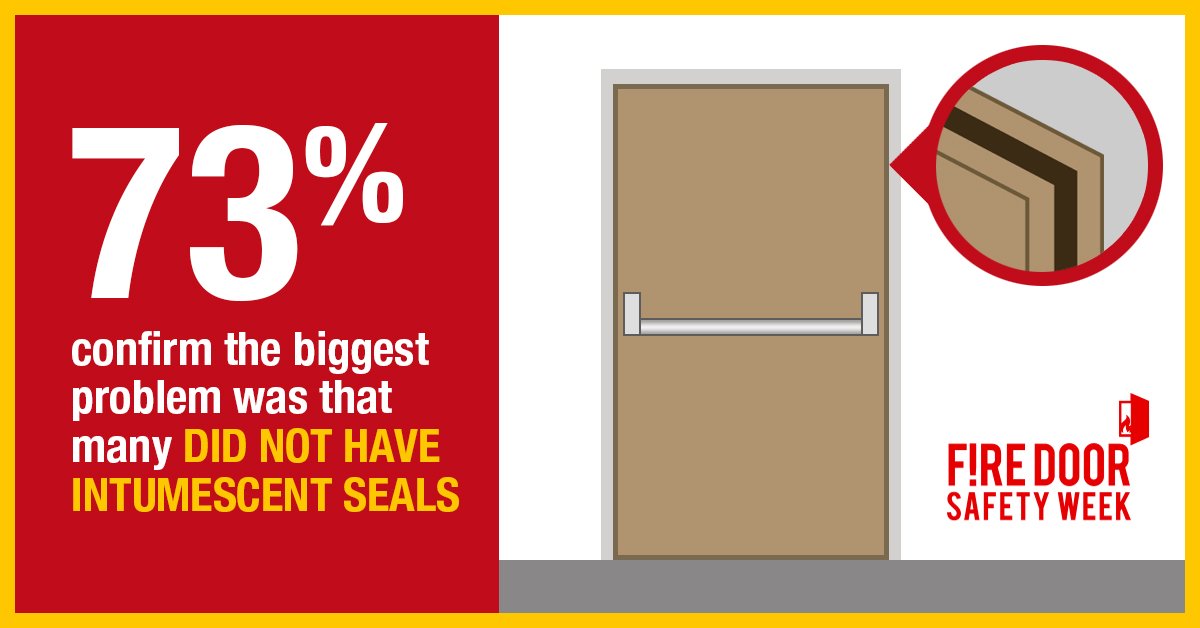
New research has revealed that commercial buildings are more likely to be breaking fire door safety regulations and putting people at risk. The research – published as part of this week’s Fire Door Safety Week (26 September – 2 October 2016) which aims to raise awareness of the critical role of fire doors, drawing attention to specific issues such as poor installation and maintenance – surveyed 860 trade professionals.
The research further revealed that over the past few years 93% of tradespeople have spotted a fire door being propped open illegally with a door stop when they have been working on a commercial or public building.
Commercial buildings containing small or medium sized businesses are the worst offenders with 72% likely to prop doors open illegally, followed by commercial buildings housing large businesses (64%) and public buildings (42%). Tradespeople are also more likely to witness this offence in older, traditional buildings (56%) than in new builds (15%).
The study, which was carried out by IronmongeryDirect, also found that 74% of tradespeople have come across a fire door that was blocked or obstructed and 58% have spotted accessibility issues with fire doors in commercial or public buildings.

When respondents were asked to reveal the most common faults they found when checking or maintaining fire doors, 73% said the biggest problem was that many did not have intumescent seals, which are vital for the fire door’s performance.
Other common breaches are doors not closing properly (63%), incorrect signage (49%), general wear and tear (47%) and loose or faulty latches (30%).
Fire Door Safety Week is giving these tips for a 5 Step Fire Door Check that anyone can do:
- Check for certification Is there a label or plug on top (or occasionally on the side) of the door to show it is a certificated fire door? You can use the selfie function on your camera phone or a mirror to check. If there is, that’s good news, otherwise report it to whoever is in charge of your building.
- Check the gaps Check the gaps around the top and sides of the door are consistently less than 4mm when closed. You can use a £1 coin to give a feel for scale, this is about 3mm thick. The gap under the door can be slightly larger (up to 8mm is not uncommon), but if does depend on the door – as a rule of thumb, if you can see light under the door, the gap is likely to be too big. It’s good news if the door fits the frame and it’s not damaged. If not, report it. If the gaps are too big smoke and fire could travel through the cracks.
- Check the seals Are there any intumescent seals around the door or frame, and are they intact with no sign of damage? These seals are usually vital to the fire door’s performance, expanding if in contact with heat to ensure fire (and in some cases smoke) can’t move through the cracks. If not, report it – the door may not be properly maintained and in the intensity of a fire may not protect you long enough.
- Check the hinges Are the hinges firmly fixed (three or more of them), with no missing or broken screws? If you see problems, report it – the door is obviously not properly maintained and in the intensity of a fire may not perform and hold back the fire for long enough.
- Check the door closes properly Open the door about halfway, let go and allow it to close by itself. Does it close firmly onto the latch without sticking on the floor or the frame? If not, report it. A fire door only works when it’s closed. A fire door is completely useless if it’s wedged open or can’t close fully.

Wayne Lysaght-Mason, managing director at IronmongeryDirect, said: “Fire safety is clearly still a significant problem concerning commercial and public buildings in the UK so having robust safety procedures in place is extremely important to ensure that building occupants and users are safe.
“Fire doors play a crucial part in the fire protection of every commercial, public and multiple occupancy building but as our research shows, more needs to be done to ensure they are installed and maintained properly to comply with fire regulations and provide the utmost protection.
“Our fire door safety checklist can make it easier to spot unsafe fire doors and we hope this encourages more people to check their condition and get them back in good working order.”
Click here to download the fire door safety checklist and for advice on choosing the right fire door hardware.
Become a Fire Door Safety Week supporter and help spread the word about the crucial importance of fire doors in saving lives and protecting property.
Fire Safety in 2023 eBook
SHP's sister site, IFSEC Insider has released its annual Fire Safety Report for 2023, keeping you up to date with the biggest news and prosecution stories from around the industry.
Chapters include important updates such as the Fire Safety (England) Regulations 2022 and an overview of the new British Standard for the digital management of fire safety information.
Plus, explore the growing risks of lithium-ion battery fires and hear from experts in disability evacuation and social housing.





Great useful information